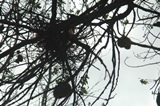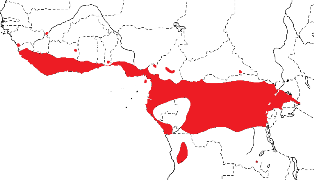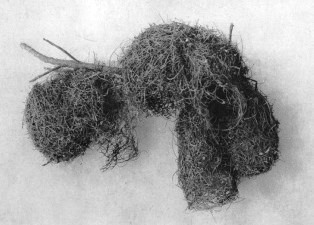Weaver species
Choose different species from drop-down list and press 'Go' button. See Full species list.Red-headed Malimbe Malimbus rubricollis
IUCN: Least concern Discovery: 041Categories: nuthatch, Malimbus, fruit, nectar, white eggs,
News items about species
Discovery
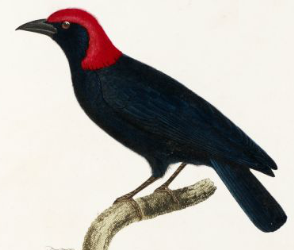
figure from Vieillot 1805 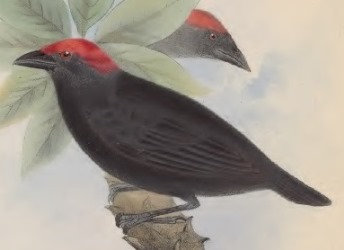
(inset is a female showing the black forehead), figure from Fraser 1849 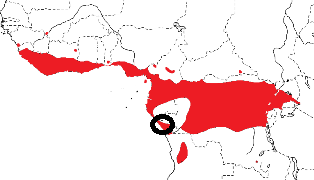
distribution, type locality circled IntroductionThe Red-headed Malimbe was formally described by William John Swainson, an English zoologist and artist.Swainson described this species based on a painting by Louis Jean Pierre Vieillot, a French ornithologist. Vieillot described several weavers from Cabinda, including this species. However, Vieillot, thought that this bird was the female of the Crested Malimbe. Ironically, he noted "We might suspect that this female would be a different species than the male above". Both Crested and Red-headed Malimbes had been collected by Jean Perrein, a French naturalist, in Cabinda - he saw both species together and thought they belonged to one species (he did not have the luxury of binoculars). Vieillot noted that Perrein collected this species in the kingdom of Congo; Perrein is known to have been based at Malimbe (now Malembo) and this is taken as the type locality. The first illustration of a Red-headed Malimbe was published by Vieillot in 1805. The next illustration was published by Fraser 1849 (of a pair collected in Sao Tome). Scientific citationPloceus rubricollis Swainson 1838 Anim. Menag., p.306 Malimba, Portuguese Congo (ex Vieillot, Ois. Chant., pl. 43).Meaning of namesrubricollis - Latin: ruber, red; Mod. L. -collis, necked.First English nameRed-crowned Euplectes (Fraser 1849).Alternate namesAngola Red-headed Malimbe, Bartlett's Red-headed Weaver, Lagos Red-headed Malimbe, Nigerian Red-headed Weaver, Red-crowned Euplectes, Red-headed Weaver, The red-necked Malimbus, Uganda Malimbe, Upper Guinea Red-headed Malimbe.CollectorJean Perrein.Date collectedBefore 1805 when Vieillot described it, and probably before 1802 when Perrein was in Cabinda.Locality collectedMalimbe =Malembo, Cabinda, Angola.Type specimensThe type may be in the Paris Natural History Museum. |
The above is based on Weaver Wednesday 2, a weekly series about the discovery of each weaver species.
This species text first appeared as
Weaver Wednesday [158] - Discovery [41]: Red-headed Malimbe on 2015-06-24
1. Basic biology
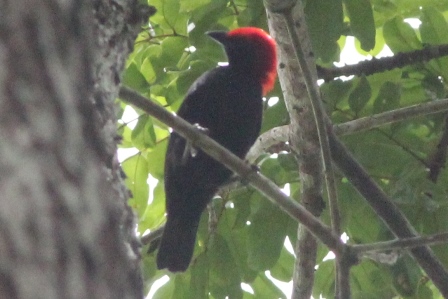
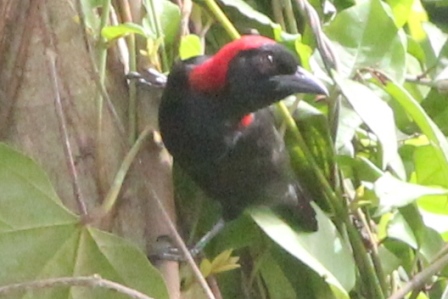
Identification. The Red-headed Malimbe Malimbus rubricollis is the most common and widespread malimbe, occurring over much of West AFrica. It differs from the similar-looking Red-crowned Malimbe by the red crown extending to the hindneck and as a half-collar on the sides of the neck. It differs from other malimbes by its all-black underparts. The female Red-headed Malimbe is similar to the male, but the forehead is black. The juvenile is sooty black, and the red on the head is paler and the bill is dark horn. Distribution. The Red-headed Malimbe occurs from Guinea across West Africa and to East Africa in Uganda and extreme western Kenya (Kakamega and Nyandoro) and Bukoba in Tanzania. It is found on Bioko Island and south to northern Angola (see map below, based on Birds of Africa). Several races have been proposed, but the differences are slight and it is now treated as monotypic.
Habitat. The Red-headed Malimbe inhabits lowland primary forest, as well as transitional forest, forest edges and clearings, and secondary growth. It is sometimes found in coffee and cocoa plantations, and in small forest patches within farmland. Food. The Red-headed Malimbe is largely insectivorous, prey items including ants, beetles, grasshoppers, caterpillars and other insect larvae, and alate termites. Other food items are small snails, spiders, fruits and berries. Its diet has been estimated as 50% arthropods, 30% fruit, 20% other material. It feeds mainly in the canopy, generally 15-45 m high and seldom below 25 m. The Red-headed Malimbe hops along horizontal branches, clambers about, often hanging upside-down; it probes bark, lichens and patches of moss, prying with its bill in search of grubs. It often forages like a woodpecker, unlike other malimbes. It hawks winged termites and other flying insects in forest clearings. It forages in pairs or small parties, and joins mixed-species flocks.
Breeding. The Red-headed Malimbe is monogamous and a solitary breeder. Courtship consists of male pursuits, and song bows to the female, followed by nest-invitation displays, and courtship feeding. The nest is retort-shaped with a short, wide entrance tunnel of about 25 cm length. Sometimes 2-5 nests are clustered together, probably all built by one pair, and some nests may be fused together. The nests are built of tendrils of creepers, grass blades and rootlets of epiphytic orchids. The brood-chamber is usually unlined. The nest is suspended from its top below a branch, 6-45 m above the ground. Nests have been found close to occupied Palm-nut Vulture Gypohierax angolensis nests, or close to wasp nests. The eggs (clutch 2) are pure white, sometimes with reddish spots. Little else is known about its breeding habits. |
The above is based on Weaver Wednesday, a weekly series about weaver species.
This species text first appeared as
Weaver Wednesday [92]: Red-headed Malimbe on 2014-03-19
2. Breeding facts
| Pair bond Monogamous Breeding season Jul in Sierra Leone, Jan-Apr in Liberia, Dec-Mar in Ghana, Mar in Togo, Apr-May in Benin, mainly Nov-Apr (but activity at nests in all months except Jun and Oct) in Nigeria, in DRCongo, May and Oct in Ituri region and Jan-Mar in Kivu; Feb-Mar in Angola, Apr-Aug in Uganda and Feb in Kenya Nest site suspended from top below a branch, 6-30 m above ground in secondary habitats, 30-45 m up in primary forest Nest building no information Colony size Solitary nester, or in small colonies of up to five nests Clutch size 2 eggs Egg colour pure white, sometimes with reddish spots Egg size no information Incubation no information Chicks and nestling period no information |
Breeding information based on Handbook of the Birds of the World, Vol. 15.
3. Photos of Weaver Nests
 Vm 5337 |
Thumb-nails of most recent PHOWN records - click on one to see its full record
See all PHOWN records for this species here.
PHOWN (Photos of Weaver Nests) provides valuable info on breeding distribution and colony sizes of weavers.
You can contribute by registering and submitting photos at Virtual Museum webpage.
4. Breeding distribution
Google map showing distribution (For species with small ranges you need to zoom in at the correct area to see the range):
yellow blob - range of weaver species; read more about this here.
![]() - PHOWN records with photos
- PHOWN records with photos
![]() - PHOWN records with no photos (Nest Record Cards, other records)
- PHOWN records with no photos (Nest Record Cards, other records)
![]() - Birdpix records
- Birdpix records
![]() - comments on out of range records, or interesting records
- comments on out of range records, or interesting records
![]() - type locality
- type locality
CLICK on the marker on the map to see individual record details.
5. Range changes
Not South African speciesThe above is based on Weaver Wednesday 3, a weekly series about range changes in South African weaver species.
This species text first appeared as
n/a








